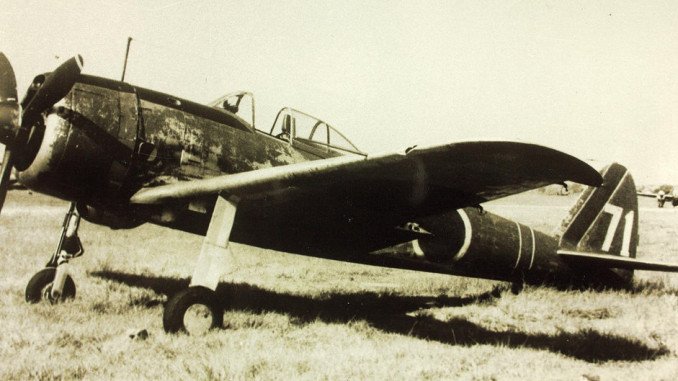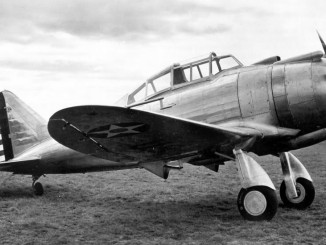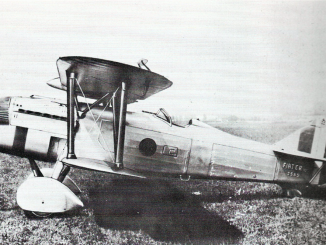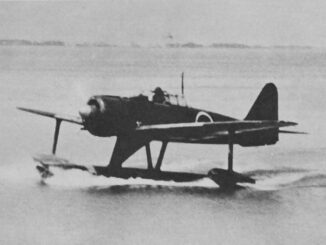
Requirements were issued by the Imperial Japanese Army Air Force in 1937 for a replacement for the Ki-27, which was just entering squadron service. The new fighter was to have the same manoeuvrability as the older aircraft but with higher top speed and an extended range capability. Nakajima appointed Hideo Itokawa as the lead engineer on the Nakajima Ki-43 project.
The prototype of the new fighter was initially a disappointment in that it was unable to compete with the Ki-27 in a level dogfight, and was not much faster than the older model despite having a more powerful Nakajima Ha-115 engine and streamlined, retractable undercarriage. Improvements were made to later prototypes including a ‘Fowler’ type flap as trialled on the new Ki-44 fighter, which resulted in an improvement in agility sufficient to satisfy the IJAAF. Armament was initially the same twin 7.7mm machine guns as the Ki-27, but was later upgraded to 12.7mm weapons.
Problems became evident during the initial deployments as wing structures were found to be defective. Upgraded models were made available to the 59th and 64th that would take the Ki-43 into combat as the Pacific War began. The fighter dominated the skies over Malaya, Burma, and the Netherlands East Indies where it was often mistaken for the Zero due to their similar profiles. Indeed, the aircraft was often referred to as the “Army Zero”.
Later in the war Ki-43s were to be found in New Guinea, where they began to encounter Allied fighters with superior performance such as the P-38 Lightning and the F4U Corsair. In the hands of a competent pilot the Ki-43 could still be competitive, but as the standards of Japanese pilot training declined so did the effectiveness of the fighter. As the Allied counter offensive continued during 1944 the Ki-43 became a liability, and towards the end of the war it was primarily used in the kamikaze role.
In 1942 the Ki-43 was assigned the Allied Reporting Name “Oscar” in the Southwest Pacific and “Jim” in the China-Burma-India Theatre. When the duplication, was noticed, “Oscar” became the preferred reporting name.
Nakajima Ki-43 Type 1 Specifications
| Nakajima Ki-43-I Hayabusa | |
| Role | Fighter |
| Crew | 1 |
| Powerplant | 1x Nakajima Ha-25 (1,000hp) |
| Speed | 199mph (cruise) 308mph (max) |
| Ceiling | 38,500ft |
| Range | 745 miles (internal) |
| Armament | 2x Ho-103 12.7mm Machine Gun 2x Type 89 7.7mm Machine gun |
| Ordnance | 331lb bombs |
| Dimensions | 29ft 0in (length) 37ft 6in (wingspan) 10ft 9in (height) |
| Wing Area | 237 sq.ft. |
| Weight | 3,483lb (empty) 4,515lb (gross) 5,695lb (max) |
| Number produced | 716 |
| Nakajima Ki-43-II Hayabusa | |
| Role | Fighter |
| Crew | 1 |
| Powerplant | 1x Nakajima Sakae 31 (1,210hp) |
| Speed | 273mph (cruise) 329mph (max) |
| Ceiling | 36,750ft |
| Range | 1,095 miles (internal) 1,990 miles (external) |
| Armament | 2x Ho-103 12.7mm Machine Gun |
| Ordnance | 331lb bombs |
| Dimensions | 29ft 3in (length) 35ft 7in (wingspan) 10ft 9in (height) |
| Wing Area | 228 sq.ft. |
| Weight | 4,211lb (empty) 5,710lb (gross) 6,450lb (max) |
| Number produced | 5,620 |
| Nakajima Ki-43-III Hayabusa | |
| Role | Fighter |
| Crew | 1 |
| Powerplant | 1x Nakajima Ha-115-II (1,230hp) |
| Speed | 275mph (cruise) 358mph (max) |
| Ceiling | 37,400ft |
| Range | 1,320 miles (internal) |
| Armament | 2x Ho-103 12.7mm Machine Gun |
| Ordnance | 331lb bombs |
| Dimensions | 29ft 3in (length) 35ft 7in (wingspan) 10ft 9in (height) |
| Wing Area | 228 sq.ft. |
| Weight | 4,233lb (empty) 5,620lb (gross) 6,750lb (max) |
| Number produced | 12 |




The Ki 43 had only 2 guns for the duration.
No fighter had a better wingloading. So it could afford wing-guns and still have more agility than Allied fighters.
Since the Oscar was so agile, it could always return fire and score hits after getting bounced. It would be interesting to see this with 40mm Ho-301 caseless cannons in it’s wings. Each 40mm hit was fatal.
This cannon proved unsuited to bomber interception, so try it on the best dogfighter! It’s the lightest (49Kg) and fastest (450 r/m) 40mm cannon of WW2 and has no recoil! It would take practice and discipline to fire 1 shell at a time, 2 at most, to conserve ammo of only 10 r/g, however.
At least the Oscar would no longer be under-gunned.
It was also under-powered. This also had a cure. The reliable 1560 hp Ha-112-II was the answer mid-war. Imagine if that happened?
Since it did not, the obsolete 25,000 man-hour Oscar was produced to the end at the expense of the better Ki 44 interceptor and unreliable Ki 84 fighter. The IJN did the same thing.